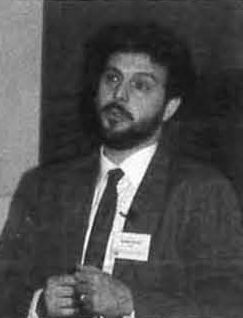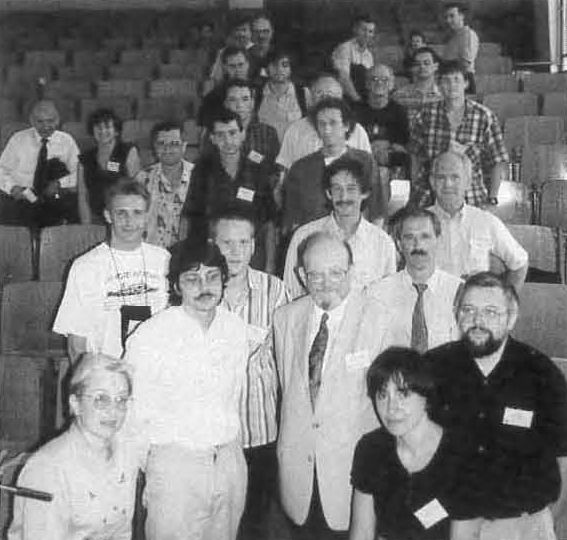
Meeting report
More from ECM 18, Prague
Industrial applications at neutron and synchrotron sources
 P. G. Radaelli at the ECM microsymposium on Magnetic Materials. He will give a plenary lecture in Glasgow (Photo WLD)
P. G. Radaelli at the ECM microsymposium on Magnetic Materials. He will give a plenary lecture in Glasgow (Photo WLD)
 Speakers (A. Pobokov, V. Klemm, M. Drakopoulos, R. Barabash, H. Leipner, M. Chall , and O. Zahararko) join their audience at the Defects and Microstructure microsymposium at ECM18. (photo WLD)
Speakers (A. Pobokov, V. Klemm, M. Drakopoulos, R. Barabash, H. Leipner, M. Chall , and O. Zahararko) join their audience at the Defects and Microstructure microsymposium at ECM18. (photo WLD)
The microsymposium on INDUSTRIAL APPLICATIONS AT NEUTRON AND SYNCHROTRON SOURCES (A6) began with an overview on applications of neutron diffraction to materials science, ranging from residual stress to texture analysis and phase analysis in thick components (M. Daymond, ISIS). Other presentations concerned neutron diffraction at the Czech facility (P. Lukas, NPI), kinetics studies of the hydration process, on-line and X-ray diffraction to clinker quality control in cement manufactures (M. Bellotto, CTG) and energy-dispersive X-ray diffraction studies at Daresbury (P. Barnes, Birkbeck College). P. Scardi described the new synchrotron radiation XRD station at Elettra (Italy) for thin film and surfaces anaysis of polycrystalline materials.
P. ScardiThe Internet in crystallography
At the microsyposium on The Internet in Crystallography (F2) G.J. Kearley and D. Richard (France) showed how the WWW can be used to provide a graphic user interface for running data analysis programmes on a remote central server (http://barns.ill.fr). The WWW server uses Java and the BARNS interface was demonstrated by video projection from a local computer running the server and the WWW client. G. Chapuis and W. Hardaker (France) demonstrated an interactive WWW course on crystallography "Discovering Symmetry" (http://www-sphys.unil.ch/symmetry/). H. Flack described the IUCr on-line information service (http://www.iucr.org/) L. Cranswick (UK) demonstrated his NEXUS CD-rom collection of the best of the crystallographic internet (http://www.unige.ch/crystal/stxnews/nexus/index.htm). F. Allen (UK, http://www.ccdc.cam.ac.uk/) said that the CSD can be accessed via the Internet under controlled circumstances within certain countries. A. Hewat (ILL) described the ICSD-for-WWW interface (http://www.ill.fr/icsd) which allows full access to the Inorganic Crystal Structure Database via a graphic user interface and the tools for generating 3D drawings, indexed plots of powder patterns, bond length and valence-bond calculations.
A. HewatStructural biology in Central and Eastern Europe
In a discussion session on Structural Biology in Central and Eastern Europe (F4), E.N.Baker described establishing macro-molecular crystallography in New Zealand in the 1970s. His list of required resources included a supportive biological community, collaborators, politicians, and funding agencies; an accessible problem; helpful, innovative and enthusiastic students; essential in-house equipment (X-ray generator, crystal freezing, computing); access to synchrotrons and travel money. Structural biology initatives in Europe were described by M. Jaskolski (Poland), J. Sevcik (the Slovak Republic), D. Turk (Slovenia), B. Schneider (Czech Republic), B. Kamenar (Croatia) and V. Harmat (Hungary). In Poland, Slovenia, Hungary and the Czech Republic, the equivalent of 400,000 - 500,000 $US was used to set up structural biology groups. Sustained efforts will require economic stability, sustained interest of the biological community, salaries sufficient to attract and keep young people, an industrial sector willing, and able, to collaborate in and finance research; a fund to maintain the equipment, and attract scientists from abroad. There is a need for collaboration within the east European countries and continuing support by western Europe. Possible source of financial support for Structural Biology in Central and East Europe discussed included the EC, INTAS and COPERNICUS programs; the UK Royal Society, NATO, the Soras Foundation, Howard Hughes, ESF and EMBO. The participants of the Microsymposium agreed to form a consortium of macromolecular crystallography groups across Central and Eastern Europe. (M. Jaskolski, Poland, chair) to reinforce collaborations between these countries and to promote their interests within Europe.
A. Lewit-BentleyTeaching Crystallography
D. Schwarzenbach began the session on Teaching Crystallography (F8) with a discussion of how to teach crystallography to different students (physicists, chemists, mineralogists and materials scientists) and raised the question "What is basic crystallography?" which led to a lively discussion of symmetry and Bragg´s law. Other symposium topics included: "An Interactive Book on Crystallography" (G. Polidori), "Crystallography for Geologists: Twenty Years Later" (D. Yu. Pushcharovsky) and "Teaching Crystal Growth as an Educational Activity in Crystallography"(N. Leonyuk). C.M. Gramaccioli discussed the significance of symmetry in spectroscopy and quantum mechanics and the central role that crystallography plays in solid state physics and chemistry. K. Crennel, discussed "Educational and Teaching Activities of the British Crystallographic Association", which are reflected in the BCA home pages: URL http://gordon.cryst.bbk.ac.uk/BCA/index.html.
A. Oskarsson


